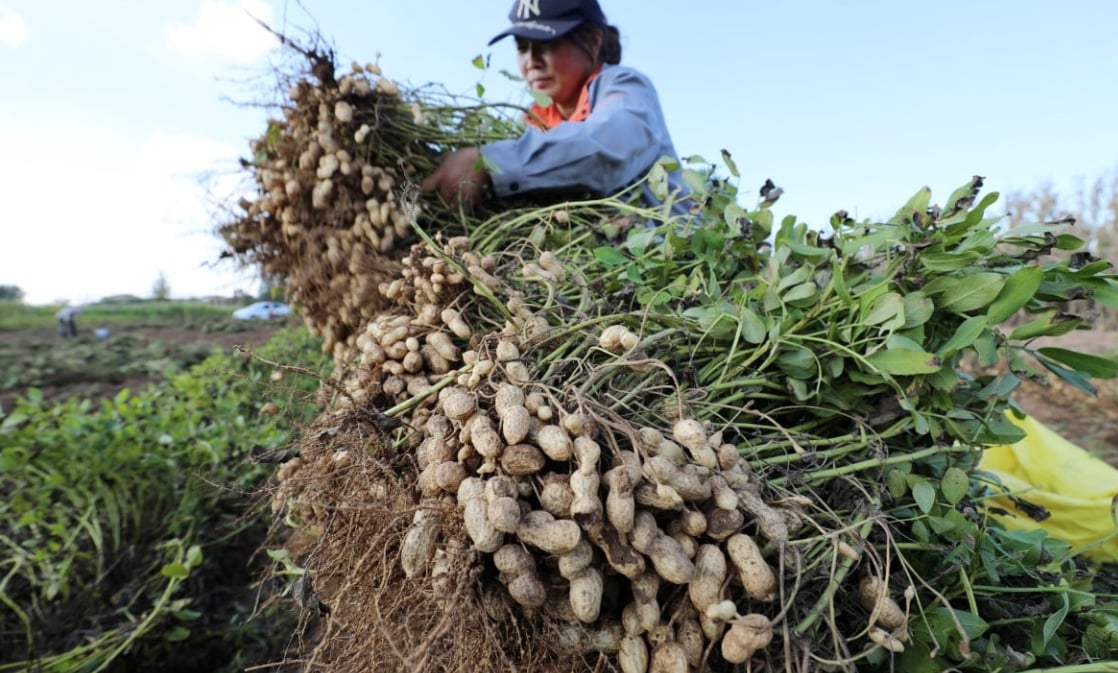June 17, 2025 | 22:26 GMT +7
June 17, 2025 | 22:26 GMT +7
Hotline: 0913.378.918
June 17, 2025 | 22:26 GMT +7
Hotline: 0913.378.918

A villager in Shannantou village, Shandong province sorts harvested peanuts on August 30, 2023. Agricultural and food self-sufficiency are a top priority for China’s government in the coming years. Photo: Xinhua
As progress continues on this front, here are some of the more notable achievements made in 2023 thus far.
China harvested its first crop of home-grown durians in late July from its southern tropical island of Hainan.
Though relatively small, the yield carried great symbolism. The tropical fruit, known for its potent smell, is mainly produced in Thailand, Malaysia and Vietnam.
The domestic durians were priced at around 120 yuan (US$16) per kilogram - about three times the cost of most imported durians - and their farming area was only 93.3 hectares.
As the world’s largest durian consumer market, China imported 825,000 tonnes of the fruit in 2022, according to customs data.
The Ministry of Agriculture announced in late August it would widen its trial of genetically modified (GM) corn and soybeans to 20 counties across five provinces.
It also started GM seed production in northwestern Gansu province this year.
In an article published in Farmers’ Daily, its official publication, the ministry attempted to ease public concerns that GM food may cause cancer and infertility by citing examples of its safe adoption in other countries. To ensure stable food production, the technology - which is estimated to increase corn and soybean yields by 5.6 to 11.6 per cent - could be essential.
China began exporting its home-grown white-feathered chicken to Tanzania in June.
The fast-growing, meaty breed represents nearly 50 per cent of China’s poultry production, according to the China Animal Agriculture Association.
Due to an avian flu outbreak in North America and a nosedive in the number of international flights, China reduced its reliance on the United States last year, according to a February report by Guosen Securities. The US is a major import destination for China’s breeder white-feathered chickens.
The introductory self-sufficiency rate of China’s “Shengze 901” breed increased from 10.56 per cent in 2021 to 25.82 per cent last year, the report stated.
China’s self-sufficiency rate in soybeans went up 3 percentage points last year, reaching 18.5 per cent according to the Ministry of Agriculture and Rural Affairs.
The world’s biggest soybean importer, China decreased its intake to 91.1 million metric tonnes in 2022, a drop of 5.6 per cent year on year according to China’s Ministry of Commerce.
Imports from the United States and Brazil, China’s two major sources of the crop, fell by 10 per cent and 6 per cent, respectively.
The ministry vowed to grow domestic soybeans at an annual rate of 7 per cent over the next decade and achieve a 30.7 per cent self-sufficiency rate by 2032. It made the pledge in its Agricultural Outlook Report for 2023-32, published in April.
China announced it had made a breakthrough in growing salt-tolerant rapeseed after a trial in the coastal Dongtai county of eastern Jiangsu province this June, according to a report released by China Science Daily, a newspaper affiliated with the Chinese Academy of Sciences.
This new species achieved a total of 323.87kg per mu harvested, which represents an increase of 59.5 per cent from the average yield.
Total oil production from the rapeseed could reach 163.17kg per mu, a theoretical increase of 82.7 per cent.
China has begun to develop seawater aquafarming in the inland Xinjiang Uygur autonomous region, raising freshwater fish, king prawn, abalone and lobsters.
The aquaculture firm Shi Shi Xian has developed a method to simulate seawater in its fishery on the edge of the desert using the region’s natural salinity.
China hopes to lift its aquatic production to 69 million tonnes by 2025, and the Xinjiang government is aiming to increase its own annual output to around 30,000 tonnes by the same year.
(SCMP)

(VAN) Extensive licensing requirements raise concerns about intellectual property theft.

(VAN) As of Friday, a salmonella outbreak linked to a California egg producer had sickened at least 79 people. Of the infected people, 21 hospitalizations were reported, U.S. health officials said.

(VAN) With the war ongoing, many Ukrainian farmers and rural farming families face limited access to their land due to mines and lack the financial resources to purchase needed agricultural inputs.

(VAN) Vikas Rambal has quietly built a $5 billion business empire in manufacturing, property and solar, and catapulted onto the Rich List.

(VAN) Available cropland now at less than five percent, according to latest geospatial assessment from FAO and UNOSAT.

(VAN) Alt Carbon has raised $12 million in a seed round as it plans to scale its carbon dioxide removal work in the South Asian nation.

(VAN) Attempts to bring down the price of the Japanese staple have had little effect amid a cost-of-living crisis.